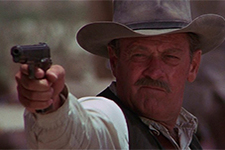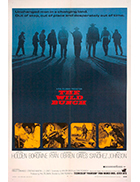The Wild Bunch
|  Sam Peckinpah was as ambiguous as the films he made. He was one of the most complex, overmystified, misinterpreted, and brilliant filmmakers to ever emerge from Hollywood’s ranks; he was a legend in his own time, the most macho of macho men who had a well-known reputation for hard drinking, gambling, fighting, and being one of the most difficult directors to work with. He was a man who admitted to identifying with the outlaws he portrayed in his films. Sam Peckinpah was as ambiguous as the films he made. He was one of the most complex, overmystified, misinterpreted, and brilliant filmmakers to ever emerge from Hollywood’s ranks; he was a legend in his own time, the most macho of macho men who had a well-known reputation for hard drinking, gambling, fighting, and being one of the most difficult directors to work with. He was a man who admitted to identifying with the outlaws he portrayed in his films.Although all of Peckinpah’s films are important in one way or another, The Wild Bunch stands as his master achievement. It is not only Peckinpah's best film, but one of the most important films of its era for the way it revolutionized the use of violence in the cinema and completely rewrote the Western genre. Peckinpah’s introduction of personal honor mixed with complex moral ambiguity to create disillusioned antiheroes threw the black hat-white hat ideals of earlier and simpler westerns out the window, thus creating a niche for future films like Arthur Penn’s Little Big Man (1970), Robert Altman’s McCabe & Mrs. Miller (1971), and Clint Eastwood’s Unforgiven (1992). The Wild Bunch is essentially a chase film in which the Bunch themselves, consisting of Pike Bishop (William Holden), Dutch Engstrom (Ernest Borgnine), Lyle Gorch (Warren Oates), Tector Gorch (Ben Johnson), and Angel (Jaime Sanchez) are being pursued by a former companion, Deke Thornton (Robert Ryan), who respects them more than the law he is forced to serve against his will (if he doesn’t capture them within 30 days, he will be sent back to prison where he has been brutally beaten). The films takes place in Texas and Mexico in 1913—a time of change when the honor and loyalty of Old West is being gradually replaced by modernization and innovations of the Industrial Revolution, which we see in the form of cars, airplanes, and machine guns, constantly reminding us that the world is moving on. The ideals the Bunch hold so dear are as old as the West itself; they hold loyalty and honor above everything else, and if they have to kill women and children to stay together, they'll do just that. It's a rather twisted version of morality, but no more twisted than the values of greed and corruption that infect the purveyors of law and order. Pike says, “When you side with a man, you stay with him. And if you can’t do that, you’re like some animal. You're finished ... we’re finished.” Pike stands at the center of the Bunch, a strong, but ultimately human man who knows he is doomed, but persists anyway. When Dutch tells Pike, “They'll be waiting for us,” Pike replies simply, “I wouldn't have it any other way ... We’re finished, all of us.” Pike’s persistence and honor make him a hero of sorts, but that is not enough save him from a world that is intent on killing off his kind. From the onset of the film, it is apparent that the Bunch cannot survive. Theirs is an old world that has no place in industrialized society. They show genuine surprise when they see an automobile and they talk about airplanes as if they are spaceships, which to them, they are. When they rob a train, they are surprised to find a modern Maxim machine gun and grenades, weapons that easily dominate the six shooters and shotguns by which they have lived their lives for so long. It is an ironic joining of the two worlds in the film's apocalyptic final battle when first Lyle, then Tector, and ultimately Pike take control of the machine gun and turn the ultimate symbol of the new world that has killed them into the one thing that allows them to survive in the battle as long as they do. Although The Wild Bunch is a superbly crafted film with strong characterizations and intense questions of morality, it is probably most famous for its scenes of graphic violence that broke all the previous conventions and set new rules for bloodletting in the cinema. The violence in The Wild Bunch is awe-inspiring, something that transcends the normal levels and reaches a virtually unheard-of stage that likened to a “blood ballet.” The film’s climactic battle scene was shot with as many as six Panavision, Mitchell, and Arriflex cameras that were all running at the same time at different speeds with different wide angle, telephoto, and zoom lenses. Then, in a feat of editing that was nothing less than astounding, Peckinpah and his editor Lou Lombardo assembled hundreds of feet of footage into one of the most carefully constructed and visually arresting montage sequences ever seen on film, standing alongside the Odessa Steps sequence in Sergei Eistenstein’s Battleship Potemkin (1925) and the shower scene in Alfred Hitchcock’s Psycho (1960). The levels of violence in The Wild Bunch have always been a point of controversy among both film critics and filmgoers. Some said the violence was excessive, while others praised it for being realistic and bold. It has been pointed out by many that the violence in The Wild Bunch isn’t truly “realistic” because it is so highly stylized through the use of slow motion and close-ups. Peckinpah argued that he had to make it larger than life in order to make up for the inherent distancing factor a viewer feels when watching a movie. But, Peckinpah never intended for the violence in The Wild Bunch to be seen as “beautiful” or “thrilling.” He wanted it to be as horrifying and gruesome as true violence is. According to Peckinpah, violence is “ugly, brutalizing, and bloody fucking awful. It’s not fun and games and cowboys and Indians, it’s a terrible, ugly thing. And yet there’s a certain response that you get from it, an excitement, because we’re all violent people, we have violence within us ... I think everybody will be a little sickened by it, at least I hope so, or a little dismayed, at least dismayed—which is the effect that I’m trying for.” The Wild Bunch is still a potent film today even though it does not retain quite the shock value it held in 1969. Still, it is a revolutionary film that rewrote the Western genre and created a new medium for depicting realistic violence on screen. The Wild Bunch is a film as complex and masterful as the man who directed it. Copyright © 1995 James Kendrick |
Overall Rating: 


 (4)
(4)


